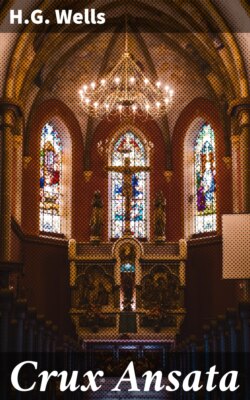Читать книгу Crux Ansata - H.G. Wells - Страница 9
VI. — THE CHURCH SALVAGES LEARNING
ОглавлениеIF the dark disorders of the decline and fall of the Roman Empire, the newly organised Catholic Church played an important role in the preservation of learning and social ideas. St. Benedict and Cassiodorus in particular set themselves to the salvage of books and teaching, and among their immediate followers was one of the first great Popes, Gregory the Great. In those days the local Christian priest was often too ignorant,to understand the Latin phrases he mumbled and muttered at his services. Gregory's educational energy corrected that. He restored the priests' Latin. So that later the Catholic Church retained its widespread solidarity in spite of the most extraordinary happenings in Rome. It would no doubt have preferred to keep its Latin language without the Latin classics, but their use was unavoidable if the language was to be steadied and sustained.
St. Benedict was born at Spoleto in Italy, a young man of good family. The shadow of the times fell upon him, he conceived a disgust for the evil in life, and, like Buddha a thousand years before him, he took to the religious life and set no limit to his austerities. Fifty miles from Rome is Subiaco, and there at the end of a gorge of the Anio, beneath a jungle growth of weeds and bushes, rose a deserted palace built by the Emperor Nero, overlooking an artificial lake that had been made in those days of departed prosperity by damming back the waters of the river. Here with a hair shirt as his chief possession, Benedict took up his quarters in a cave in the high southward- looking cliff that overhangs the stream, in so inaccessible a position tat his food had to be lowered to him on a cord by a faithful admirer. Three years he lived here, and his fame spread as Buddha's did, as a great saint and teacher.
Presently we find him no longer engaged in self-torment, but controlling a group of twelve monasteries, the resort of a great number of people. Youths are brought to him to be educated, and the whole character of his life has ceased to be ascetic.
From Subiaco he removed to Monte Cassino, half-way between Rome and Naples, a. lonely and beautiful mountain in the midst of a great circle of majestic heights. Here, it is interesting to note that in the sixth century A.D. he found a temple of Apollo and a sacred grove, and the countryside still worshipping at this shrine. His first labours had to be missionary labours, and with difficulty he persuaded the simple pagans to demolish their temple and cut down their grove. The establishment upon Monte Cassino became a famous and powerful centre within the lifetime of its founder. Mixed up with the imbecile inventions of marvel-loving monks about demons exorcised, disciples walking on the water, and dead children restored to life, we can still detect something of the real spirit of Benedict. Particularly significant are the stories that represent him as discouraging extreme mortification. He sent a damping message to a solitary who had invented a new degree in saintliness by chaining himself to a rock in a narrow cave. "Break thy chain," said Benedict, "for he true servant of God is chained not to rocks by iron, but to righteousness by Christ."
Next to the discouragement of solitary self-torture, Benedict insisted upon hard work. Through the legends shine the clear indications of the trouble made by his patrician students and disciples who found themselves obliged to toil instead of leading lives of leisurely austerity under the ministrations of the lowerclass brethren.
A third remarkable thing about Benedict was his political influence. He set himself to reconcile Goths and Italians, and it is clear that Totila, his Gothic king, came to him for counsel and was greatly influenced by him. When Totila retook Naples from the Greeks, the Goths protected the women from insult and treated even the captured soldiers with humanity. Belisarius, Justinian's general, had taken the same place ten years previously, and had celebrated his triumph by a general massacre.
Now the monastic organisation of Benedict was a very great beginning in the Western world. One of his prominent followers was Pope Gregory the Great (540-604), the first monk to become Pope (590); he was one of the most capable and energetic of the Popes, sending successful missions to the unconverted, and particularly to' the Anglo-Saxons. He rules in Rome like an independent king, organising armies, making treaties. To his influence is due the imposition of the Benedictine rule upon nearly the whole of Latin monasticism.
Gregory the Great ruled in Rome like an independent king organising armies, making treaties. It was he who saw two fair captives from Britain, and, having asked whence they came and being told they were Angles, said they might be angels—non Angli sed Angeli—rather than Angles if they had the Faith. He made it his special business to send missionaries to England. This is a high water mark in the chequered history of the Roman Church. From Gregory I it passes into a phase of decadence not only at Rome but throughout its entire sphere of influence.
